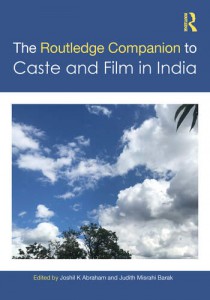The Routledge Companion to Caste and Film in India
Edited by Joshil K. Abraham and Judith Misrahi-Barak


Average rating: ![]()
| 0 | rating | |
| 0 | rating | |
| 0 | rating | |
| 0 | rating |
Your rating: -
Book Presentation:
This companion is the first study of caste and its representation in Indian cinema. It unravels the multiple layers of caste that feature directly and indirectly in Indian movies, to examine not only the many ways caste pervades Indian society and culture but also how the struggle against it adopts multiple strategies.
The companion:
• Critiques Indian cinema production through the lens of anti-caste discourse;
• Traces the history of films beginning from the early twentieth century, focusing on caste representations across India, including Hindi, Malayalam, Kannada, Marathi, Bengali, Punjabi, Tamil as well as silent films;
• Makes a foray into OTT media;
• Includes analysis of popular films such as Padmaavat, Masaan, Fandry, Sairat, Sujata, Article 15, Chomana Dudi, Lagaan, Court, Ee.Ma.Yau, Kaala, Pariyerum Perumal, Perariyathavar, among many others, to critique and problematise the idea of caste.
A major intervention, this book alters traditional approaches to ‘caste’ in Indian cinemas and society and explores new political strategies implemented through cinematic creation and aesthetics. It will be indispensable for scholars and researchers of film studies, social discrimination and exclusion studies, human rights, popular culture, and South Asian studies. It will also be of interest to enthusiasts of Indian cinematic history.
About the authors:
Joshil K. Abraham is an independent researcher. He is currently working on the Open University project for Cornerstone OnDemand.
Judith Misrahi-Barak is Associate Professor at Université Paul Valéry Montpellier 3, France. She teaches in the English Department and is a member of the research center EMMA.
See the publisher website: Routledge
> On a related topic:
Indian Cinema Today and Tomorrow (2024)
Infrastructure, Aesthetics, Audiences
by S. V. Srinivas, Ratheesh Radhakrishnan, Subhajit Chatterjee and Omita Goyal
Mourning the Nation (2009)
Indian Cinema in the Wake of Partition
Amar Akbar Anthony (2016)
Bollywood, Brotherhood, and the Nation
by William Elison, Christian Lee Novetzke and Andy Rotman
Subject: One Film > Amar Akbar Anthony
The Revolution of Indian Parallel Cinema in the Global South (1968–1995) (2025)
From Feminism to Iconoclasm
by Omar Ahmed
A History of India's North-East Cinema (2025)
Deconstructing the Stereotypes
Muslim Identity in Hindi Cinema (2025)
Poetics and Politics of Genre and Representation